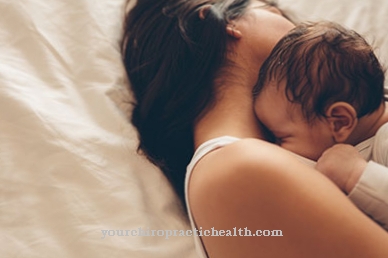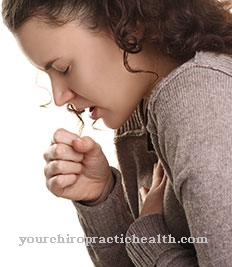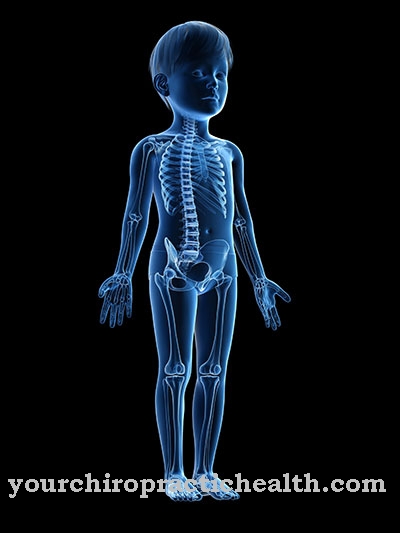The term Ankylosis refers to a joint stiffening. This is not muscular - that would be a contracture - but rather through disease processes in the joint itself. Mostly it is inflammation processes that lead to connective tissue scarring and thus immobility of the joint bodies.
What is ankylosis?

© Henrie - stock.adobe.com
The joints are of fundamental importance for the mobility of the body - it is easy to imagine that stiffening of the joint, as in ankylosis, is a real problem for those affected.
The exact causes are quite diverse, but can mostly be traced back to inflammatory processes and genetic bases. The "most famous" representative among the ankyloses is probably Bechterew's disease, which is why it is also called "ankylosing spondylitis". The following is an overview of the topic of "ankylosis" in general.
causes
There are various causes of joint stiffness (ankylosis). Basically, in fibrinous ankylosis, connective tissue bridges are created between the cartilage surfaces and the inner joint membranes, which grow together and thereby render the joint immobile.
Inflammation processes that last for years are usually present, as in gout, rheumatoid arthritis or psoriatic arthritis. In more severe cases, there may even be real bony adhesions (bony ankylosis). In ankylosing spondylitis, the sacroiliac joint between the sacrum and iliac sacs is particularly affected, which leads to deep-seated back pain and progressive inability to move in the spine.
Genetic conditions are known that lead to an increased susceptibility to ankylosing spondylitis as well as to other ankylosing diseases, especially a certain expression of the HLA-B27 gene. Bechterew's disease often affects men between the ages of 15 and 30 - so ankylosis is by no means just a problem for older people.
With Scheuermann's disease, too, the thoracic vertebral bodies stiffen during puberty, which leads to the typical symptoms of the hunched back. Bad posture and muscular overload are blamed for this.
There are even cases of congenital ankylosis - when the joints are not born flexible in the womb due to growth and development disorders (congenital ankylosis).
Otherwise, chronic osteoarthritis or any other inflammation of the joints can cause joints to stiffen over the long term. If a joint is intentionally stiffened for medical reasons (e.g. to spare other structures or to treat movement-dependent pain), it is called "arthrodesis".
Symptoms, ailments & signs
In the case of ankylosis, there are primarily restricted mobility. This is accompanied by pain in the joint, triggered by the chronic inflammation and accompanying symptoms such as joint wear and tear or muscle tension. Older people can experience chronic stiffness, known as joint stiffness. Ankylosis can also manifest itself as osteoarthritis or arthritis.
Ankylosing spondylitis causes nocturnal pain, which is also due to the inflammation of the joints. As the disease progresses, the spine also stiffens. Then there is a pronounced hunchback and further restrictions on movement. If the thoracic spine is involved, breathing difficulties or even shortness of breath can occur.
Some sufferers feel a tightness in the chest, which occurs mainly at night and in the morning after getting up and which regresses during the day. If the ankylosis is not treated, the symptoms and complaints mentioned increase in intensity and ultimately also affect the psychological state of the person affected.
Then it can lead to depressive moods, mood swings and social fears due to the external changes. With early treatment, the symptoms usually subside after a while. Chronic inflammation can repeatedly cause discomfort even after therapy.
Diagnosis & course
Ankylosis leads primarily to restricted and inability to move. This is often associated with pain in the joint due to the chronic inflammation - which, however, can come to rest as the stiffness increases. Elderly sick people in particular experience great difficulties in everyday movement processes such as sitting, standing or grasping due to the ankylosing of joints - this can lead to greater or lesser disabilities in everyday life.
Bechterew's disease primarily leads to nocturnal inflammatory pain and then to progressive stiffening of the spine with a massive hunched back and restricted mobility. If the thoracic spine is affected, this can even lead to impaired breathing via the ribs.
The diagnosis of ankylosis begins with the specific anamnesis, in which the exact circumstances of the disease are asked. This includes, above all, previous damage to the joint and general previous illnesses as well as rheumatic diseases in the family.
The examination first concerns the affected joint itself, here the degrees of movement are examined and documented in writing in order to be able to objectify a chronic progression of the stiffening at an early stage. Other joints and other organs often affected by rheumatic diseases (eyes, mucous membranes) must also be examined if they are suspected.
The blood test includes general inflammation parameters and special markers such as the rheumatoid factor or the expression of the HLA-B27 gene, which can be determined if there is a suspicion, but has no evidential value for a disease (you can stay healthy for life with HLA-B27). In addition, a process in the joint space can be made visible by means of ultrasound, X-rays or other imaging measures.
When should you go to the doctor?
If you suspect ankylosis, you should see a doctor immediately if possible. Medical clarification is recommended when the first movement restrictions of the joints occur. If there are also back or joint pain, it is likely an ankylosis or other condition that needs to be clarified immediately. Patients who already have osteoarthritis or osteoarthritis should discuss any unusual symptoms with their doctor.
The same applies if there are already cases of ankylosis in the family or if there is a genetic predisposition to rheumatism or osteoarthritis. Elderly people with joint, muscle or bone diseases should generally consult a doctor with joint stiffness, pain and other complaints. Medical advice is particularly important if the symptoms lead to malpositions or a decrease in wellbeing.
Then a doctor should diagnose the ankylosis and initiate treatment immediately. Other contacts are rheumatologists and orthopedists. A dentist or orthodontist should be consulted if the teeth are ankylosed.
Doctors & therapists in your area
Treatment & Therapy
The therapy of ankylosis depends on the disease. Chronic inflammation is treated with non-steroidal anti-inflammatory drugs such as ibuprofen, and there are also many special immunomodulating agents that can stop the process of stiffening.
Physiotherapy is always a very important part of ankylosis therapy. Regular exercise under expert supervision helps prevent or at least stop stiffening and relieve pain. Other physical measures such as heat, cold or ultrasound therapy can also be helpful.
However, once a joint has stiffened, it will seldom regain full mobility. In advanced cases of illness, this can only be achieved with a surgical joint replacement, an endoprosthesis, which is now also available for many smaller joints.
Outlook & forecast
Without medical treatment and intervention, ankylosis has no chance of cure or symptom relief. In cooperation with a physiotherapist, tips and hints can be given for a temporary improvement in stress and movement options. This will minimize the pain or other discomfort.
A cure of the ankylosis is not possible with this support. However, due to the progressive course of the disease, there is a steady increase in symptoms. Ultimately, the joint stiffens, which can no longer be corrected without surgical intervention.
If medical care is used, there are good prospects for an improved quality of life. Replacing the affected joint can lead to a positive development in health after just a few weeks or months. If rehabilitation measures and targeted training are used, an optimized and more sustainable result can also be achieved. However, the possibilities of the movement sequences are not completely comparable with those of a healthy natural joint.
In addition, complications or defense reactions of the organism can occur, which result in further impairments and a reduction in wellbeing. With inflammatory diseases, a drug treatment method is chosen. This is also promising, so that healing occurs within a few weeks.
prevention
A prevention of rheumatic diseases such as ankylosing spondylitis is not possible or at least not currently known. However, anyone who is ill can do a lot with physiotherapy and other therapeutic measures to slow down the stiffening of the joints.
Aftercare
An ankylosis cannot yet be treated causally. Like the treatment itself, joint stiffening follow-up focuses on checking the condition of the joint at regular intervals. If the causal rheumatoid arthritis has been completely treated, the regular adjustment of the drug therapy is an important part of the follow-up care.
People with ankylosis must see a rheumatologist or orthopedic surgeon every four to six months so that the status of the underlying disease can be checked. If there are no complications, the frequency can be gradually reduced. The causal disease must be treated further during this.
Ankylosing spondylitis, in particular, requires ongoing therapy, as the symptoms increase in the course of life and, accordingly, the treatment must be continued. Ankylosis follow-up care must be interrupted in the event of complications. Joint pain or restricted mobility must be treated as part of normal therapy.
Most often, patients are prescribed pain medication.In individual cases, a doctor can surgically treat joint stiffness and the associated symptoms. Since ankylosis occurs as a result of different diseases and can develop very differently, patients should speak to the responsible doctor about follow-up care.
You can do that yourself
If you suspect a joint stiffening, you should definitely consult a doctor. This is especially true if the symptoms occur together with back and joint pain.
Since a completely stiffened joint usually never regains its full functionality, measures to prevent the disease from progressing are particularly important. This is also the best approach to self-help. Physiotherapeutic measures can help to maintain the mobility of the impaired joints.
Those affected should consult a qualified physiotherapist and have an individual training program developed. Consistency and perseverance are of crucial importance. The exercises must be carried out regularly in the prescribed manner and almost always over a long period of time. Some patients also have to come to terms with the lifelong need for physical therapy.
If the ankylosis is due to chronic inflammatory processes in connection with gout or rheumatoid or psoriatic arthritis, naturopathic drugs can be used in addition to allopathic drugs. As an alternative to non-sterodoidal anti-inflammatory drugs, devil's claw, curcumin, an active ingredient from turmeric, as well as arnica and frankincense are used. The positive influence of frankincense on the mobility of the joints in arthritis has been scientifically proven. The effect of devil's claw is also supported by relevant studies.


.jpg)
.jpg)





















.jpg)


